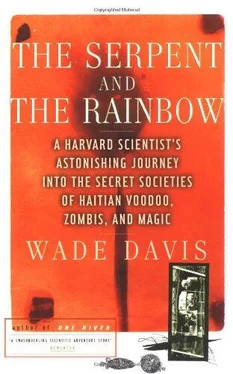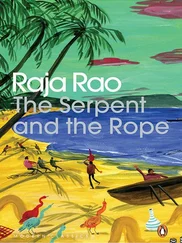Wade Davis - The Serpent and the Rainbow
Здесь есть возможность читать онлайн «Wade Davis - The Serpent and the Rainbow» весь текст электронной книги совершенно бесплатно (целиком полную версию без сокращений). В некоторых случаях можно слушать аудио, скачать через торрент в формате fb2 и присутствует краткое содержание. Год выпуска: 1985, Издательство: Simon & Schuster, Жанр: Старинная литература, на английском языке. Описание произведения, (предисловие) а так же отзывы посетителей доступны на портале библиотеки ЛибКат.
- Название:The Serpent and the Rainbow
- Автор:
- Издательство:Simon & Schuster
- Жанр:
- Год:1985
- ISBN:нет данных
- Рейтинг книги:5 / 5. Голосов: 1
-
Избранное:Добавить в избранное
- Отзывы:
-
Ваша оценка:
- 100
- 1
- 2
- 3
- 4
- 5
The Serpent and the Rainbow: краткое содержание, описание и аннотация
Предлагаем к чтению аннотацию, описание, краткое содержание или предисловие (зависит от того, что написал сам автор книги «The Serpent and the Rainbow»). Если вы не нашли необходимую информацию о книге — напишите в комментариях, мы постараемся отыскать её.
The Serpent and the Rainbow — читать онлайн бесплатно полную книгу (весь текст) целиком
Ниже представлен текст книги, разбитый по страницам. Система сохранения места последней прочитанной страницы, позволяет с удобством читать онлайн бесплатно книгу «The Serpent and the Rainbow», без необходимости каждый раз заново искать на чём Вы остановились. Поставьте закладку, и сможете в любой момент перейти на страницу, на которой закончили чтение.
Интервал:
Закладка:
As the single most important arbiter of culture, the West African secret societies had as a vital function the administration of justice, and as in the case of the leopard society among the Efik of Old Calabar, their tribunals delivered a verdict based on the outcome of the poison ordeal. Judgment by ordeal could cover any and all personal or social crimes, and was inevitably invoked in suspected cases of sorcery. Not surprisingly, the secret societies developed a particularly refined knowledge of toxic preparations, learning not only to identify and experiment with different species of plant and animal, but also to control dosage, means of administration, and even the psychological set of the potential recipient.
But the use of toxic preparations was not restricted to the secret societies, nor even among them to the ordeal tribunals. Perhaps as much as any single material trait, the manipulation of poisons remains a consistent theme through African cultures. In certain regions, for example, criminals were executed by pricking their skin with lances or needles dipped in the juice of toxic plants. In parts of West Africa when a king died, his heir had to submit at least twice to poison ordeals to prove his supernatural strength; should he fail and die, the lineage was broken and the throne was declared vacant. Individual sorcerers often used potions of course, but in one of the most extraordinary developments, poisons were used systematically by established rulers in vain atempts to purge entire populations of evil. The leaders of the Cazamance and Balantes peoples in West Africa, for example, used a preparation based in part on the bark of a tree known as tali (Erythrophleum guineense— Leguminosae). Other ingredients included the powder ground from the dried hearts of previous victims and a number of admixtures reminiscent of those used in contemporary Haiti—ground glass, lizards, toads, crushed snakes, and human remains. Placed in a vat and allowed to ferment for a year, this toxic preparation was then ceremoniously paraded on a day of great festivities and given to every citizen. Each year as many as two thousand people died. With the advent of the slave trade, however, West African rulers discovered an even better means of purging their societies. According to Moreau de Saint-Mery, the most respected of the early colonial authorities, certain kings made use of their treaties with the European merchants to get rid of their poisoners by condemning them to deportation to Saint Domingue.
When Macandal finally fled the plantation he buried his vengeance deep within his breast. He didn’t fear recapture; no planter would risk the price of valuable hounds to run down a one-armed slave, let alone a Mandingue whose very tribal name was synonymous with rebellion. Macandal’s concern was one of timing—when and how to best seek retribution. It would be easy enough to kill. Muskets and powder were available for a price from the freedmen in the cities, and even armed with clubs and a few machetes a dozen Maroons could handily overrun a plantation, burning the stables, the drying sheds, and the cursed mills, and still have time to pay their respects to the master’s wife before the militia arrived. But pillaging plantations and sacking mansions now held little attraction for Macandal, and for what he intended to do there weren’t enough guns in all the colony. Once when asked to interpret one of his dreams, he had called for a clay vessel and placed into it three kerchiefs. He pulled out one that was yellow and explained to the crowd that it was the color of the ones who were born on the land. The next one was white, and it was they who now ruled. And here, he said, finally, are the ones that shall remain masters of the island, and the color of the kerchief was black.
For six years the network spread, with the whites completely oblivious of the danger about to befall them. Macandal was everywhere, moving with the impunity of a god garnering favors and awakening the zeal of the people. He chose his agents with care and placed them in every corner of the colony, and they in turn kept him informed of potential converts—perhaps a coachman whose woman had been recently raped by the master, or a kitchen boy whipped raw for stealing bread. On parchment and bark he drew figures in charcoal, tallying in symbols that only he understood the names of the plantations and the leaders of each and every work gang that toiled beneath the relentless sun—every man and woman who would come to his cause. He wanted everyone; they could look on him as they chose so long as their eyes held terror; be it fear of God or man it mattered not to him, just terror so that the secret would remain safe. But above all he needed those who worked on the inside—the coachmen, cooks, and domestic servants, the ones whose presence in the very bosom of the whites would not sound the alarm. In that way, Macandal would be assured that with each anguished dying breath the slavers would stare into the faces of those closest to them and see only the reflection of their own evil smiles.
By night Macandal wandered, but by day he ran a school, the students spread out before him in the thick grass, their fingers releasing the musty odor of fungi, the ooze of molds, and the pungent scent of crushed venom glands. The men held Macandal in awe, and at his behest combed the island, bringing back herbs with sap that stung, evil-looking sea creatures, snakes, and toads. Together they reached deep into their collective memory, struggling with senses numb from disuse to remember the lessons taught in their youth, the formulae and preparations and ingredients that might be mirrored among the plants and animals of the new land. If Macandal was their teacher, he in turn was the apprentice of others, the old women and men who lived alone among the dripping stalactites in caves and slept on beds of bat droppings. It was they who retained the ancient wisdom, some learned in Africa and some acquired on the island from the descendants of those who had lived among the remnants of the Arawakans, the tortured sons of the caciques that had ruled the land before the arrival of the whites. In the caves, these elders studied Macandal’s discoveries, fingering the fruits that bled red and blackened in the air, the shriveled lizards, and venomous insects. What they finally approved, after years of study, Macandal placed in the belly of the mortar, broken at the edges and worn with use. Then before their eyes he ground the silent death that would one day walk across the fields, and reach into every kitchen in the land.
In time, like ink on a blotter, the poison seeped into the lives of the whites. First the cattle died, one by one, until the stiff carcasses littered the northern plain. The planters in dismay hired the best scientific minds, herbalists who left their physic gardens in the Cap to tramp across the pastures in search of some vile weed fouling the fields. For days and weeks they combed the grass. Just as they thought that they had found the guilty plant, and the work gangs had begun to sweep clean the pastures, the first of the dogs died, and word came that poison had entered the houses.
To their horror, the whites found themselves in a trap of their own making, dependent on the very people who were the agents of their doom. The poison appeared everywhere: baked into bread, in medicine vials, in kegs of ale lifted directly from the ships and drunk because the water from the wells could no longer be trusted. Entire banquets succumbed, sometimes from the soup, perhaps the tea, the wine, or even fruit picked fresh from the trees. The terror of the whites gave way to rage, and innocent slaves were flayed alive. The slightest suspicion of collaboration with the poisoners meant a horrible death. But the enemy could not be seen; only its mark was felt, universally on the whites and equally on any black who showed signs of betraying the agents of Macandal. The colonial administration declared a state of siege and emptied the garrisons to parade up and down the streets of the Cap, their guns shouldered and useless against the invisible enemy. The courts condemned whoever they imagined to be guilty, and work gangs were decimated in attempts to secure the names of the leaders of the conspiracy. The chemists and herbalists reconvened to attempt once more to identify the source of the plague, whether animal or plant, or perhaps some compound taken from the apothecary or some potion brought by the wretches from Africa. A royal proclamation prohibited any slave from concocting any remedy, or attempting to cure any sickness with the exception of snakebite. But nothing that the government did could stop the contagion. Hundreds of slaves died, and as many whites. Before Macandal was through, six thousand at least would be dead.
Читать дальшеИнтервал:
Закладка:
Похожие книги на «The Serpent and the Rainbow»
Представляем Вашему вниманию похожие книги на «The Serpent and the Rainbow» списком для выбора. Мы отобрали схожую по названию и смыслу литературу в надежде предоставить читателям больше вариантов отыскать новые, интересные, ещё непрочитанные произведения.
Обсуждение, отзывы о книге «The Serpent and the Rainbow» и просто собственные мнения читателей. Оставьте ваши комментарии, напишите, что Вы думаете о произведении, его смысле или главных героях. Укажите что конкретно понравилось, а что нет, и почему Вы так считаете.












